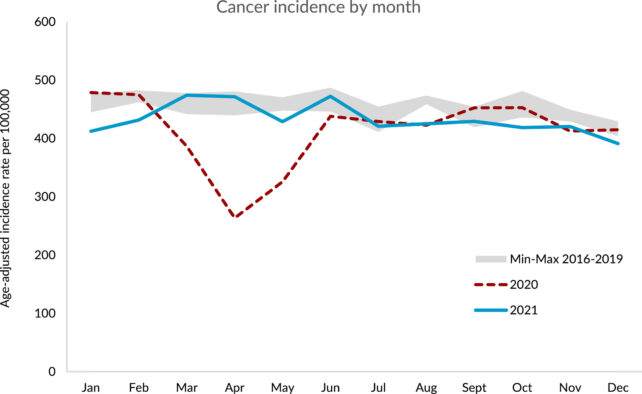Bad health news has a way of taking over the headlines, and while there are many dangerous and debilitating diseases and infections on the rise, there is also great progress being made, year on year.
In the last two decades, the overall death rate from cancer has steadily fallen, according to the United States' Annual Report to the Nation on the Status of Cancer.
While some cancer cases, like breast cancer, are gradually increasing, especially in women and younger generations, their fatality rates are generally growing less severe, and other cancers, like those associated with tobacco smoking, are on a downward trend.
From 2018 to 2022 (not counting data from 2020), the report shows new cancer cases largely plateaued for males and increased by 0.3 percent for females year on year. At the same time, cancer death rates decreased by an average of 1.7 percent per year for males and an average of 1.3 percent per year for females.
"Progress has been made in reducing overall cancer mortality, largely driven by sustained declines in lung cancer," reads the annual analysis – a collaboration from the American Cancer Society (ACS), the Centers for Disease Control and Prevention (CDC), the North American Association of Central Cancer Registries (NAACCR), and the National Cancer Institute (NCI).
"Cancer mortality declined even through the first two years of the COVID-19 pandemic."

For smoking-related cancers, the findings are particularly hopeful. The rate of new cases and the fatality rate have decreased for several smoking-related diseases, including lung, bladder, and larynx cancer.
This coincides with multiple breakthroughs in treatments for non-small cell lung cancer, as well as increased access to health care due to the Affordable Care Act (often referred to as Obamacare).
Another nationwide study from earlier this year found that between 1975 and 2020, almost 6 million deaths from five of the most common cancers (breast, cervical, colorectal, lung, and prostate cancer) were averted through a combination of prevention, screening, and improved treatments.
The new results once again "underscore the importance of public health policy to ensure continued access to cancer-related care, even during public health emergencies such as pandemics," the authors of the annual report conclude.

Still, the analysis does highlight some areas that need attention. For instance, mortality rate declines have slowed for several cancers, like colorectal and prostate cancers, partly because of a recent uptick in diagnoses.
What's more, the number of new cases for multiple cancers is also rising, particularly those associated with excess body weight, like breast, uterus, colon, rectum, pancreas, kidney, and liver cancers.
Overall, experts at the American Cancer Society warn that the burden of cancer appears to be shifting toward women and younger adults.
Their recent studies suggest cancer incidence rates in women under 50 are now 82 percent higher than their male counterparts, which is up from 51 percent in 2002.
"Continued reductions in cancer mortality because of drops in smoking, better treatment, and earlier detection is certainly great news," Rebecca Siegel, a senior scientific director at the American Cancer Society and a co-author of the recent report said in January.
"However, this progress is tempered by rising incidence in young and middle-aged women, who are often the family caregivers, and a shifting cancer burden from men to women, harkening back to the early 1900s when cancer was more common in women."
There is also a significant racial disparity that needs to be addressed. Since 1989, for instance, when breast cancer deaths peaked, the fatality rate has fallen by 42 percent. Black women, however, still experience a 40 percent higher death rate from breast cancer than White women, and that disparity has existed for decades.
"Progress against cancer continues to be hampered by striking, wide static disparities for many racial and ethnic groups," said Ahmedin Jemal, senior vice president of surveillance and health equity science at the American Cancer Society in January.
"It's essential to help end discrimination and inequality in cancer care for all populations. Taking this step is vital to closing this persistent gap and moving us closer to ending cancer as we know it, for everyone."
The 2025 Annual Report to the Nation on the Status of Cancer was published in Cancer: An International Interdisciplinary Journal of the American Cancer Society.
